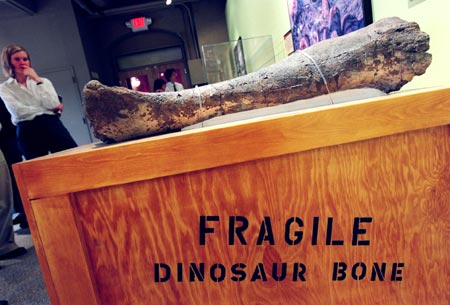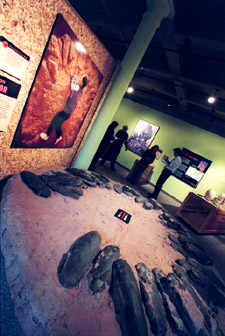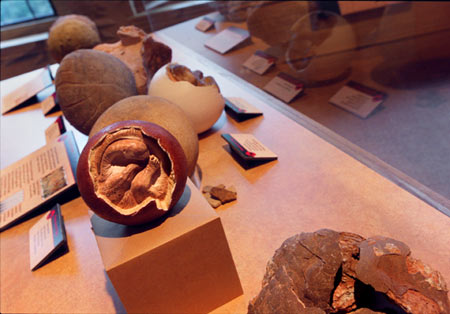HMNH breaks out of its shell:
New exhibit in new gallery presents current science on dinosaur eggs, parenting

The mother dinosaur in the Harvard Museum of Natural History’s new exhibit died crouching over her eggs protectively, probably in a Gobi Desert sandstorm, exhibiting parenting instincts that until recently scientists didn’t believe she had.
In fact, for years, scientists thought dinosaurs like her were nest predators, garnering the species the name “oviraptor” or “egg-seizer.” Though the name has stuck, the story has changed, particularly over the past decade or so.
In a new exhibit that opened Oct. 5 and runs through August 2003, the Harvard Museum of Natural History (HMNH) is presenting the new story of dinosaur eggs and parenting.

The exhibit, “Hatching the Past: Dinosaur Eggs, Nests and Young,” has about 100 eggs, half of which are real, and is the first in the HMNH’s newly renovated temporary exhibit hall, a major refurbishment of a space occupied for decades by exhibits of fossils.
“We’re trying to present current science, both what’s going on in the field and what’s going on behind our own walls,” said HMNH Executive Director Joshua Basseches at a press preview of the new exhibit on Oct. 3.
The dinosaur egg exhibit was developed by professional fossil preparators Charles and Florence Magovern of Boulder, Colo., both of whom were on hand for the preview. In 1993, Charles discovered the most intact known specimen of a baby dinosaur, dubbed “Baby Louie,” a cast of which is part of the HMNH exhibit.
“It’s so rare to find an articulated any type of a dinosaur, but to find an articulated baby, this is just unheard of,” Charles said. “The past 10 years have been just phenomenal with findings and research in eggs. This is a really fascinating new aspect of dinosaur paleontology.”

The exhibit includes a model of what Baby Louie might have looked like. About a foot long – adults are thought to have reached 30 feet – the model is covered in black-tipped gray feathers.
Studying dinosaur eggs leads to a study of parenting behavior and how dinosaurs lived, Charles Magovern said, rather than how they died. The gigantic sauropods – which grew out of eggs just eight to 10 inches wide, are now thought to have migrated annually to enormous nesting sites, returning year after year to the same place.
“The eggs teach you how they lived, their life patterns,” he said.
The Museum of Natural History is located at 26 Oxford St. Open daily, 9 a.m.-5 p.m. Call (617) 495-3045, or visit the Web site at http://www.hmnh.harvard.edu.




